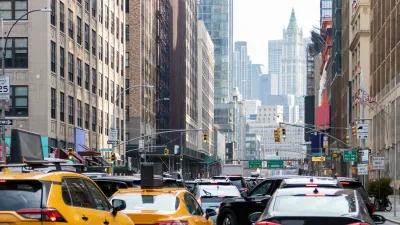The uncompromising writer, who pioneered the position of full-time architecture critic at an American newspaper, and exemplified the pinnacle of the profession for five decades, died on Monday.
Before Huxtable started at The New York Times in 1963, there had never before been a full-time architecture critic for a general-interest newspaper in the U.S. And over the next five decades of fearless criticism, she "opened the priestly precincts of design and planning to everyday readers," said David W. Dunlap in a Times obituary. "For that, she won the first Pulitzer Prize for distinguished criticism, in 1970. More recently, she was the architecture critic of The Wall Street Journal."
“'Mrs. Huxtable invented a new profession,' a valedictory Times editorial said in 1981, just as she was leaving the newspaper, 'and, quite simply, changed the way most of us see and think about man-made environments.'”
"Though knowledgeable about architectural styles," added Dunlap, "Ms. Huxtable often seemed more interested in social substance. She invited readers to consider a building not as an assembly of pilasters and entablatures but as a public statement whose form and placement had real consequences for its neighbors as well as its occupants."
In a tribute to the critic delivered at the Museum of the City of New York in 1996, the writer who followed her at the Times, Paul Goldberger, praised Huxtable as "more than just the most important pioneer of architectural criticism in newspapers in our time: she has been the most important figure in communicating the urgency of some kind of belief in the values of the man-made environment in our time, too. She has made people pay attention. She has made people care. She has made architecture matter in our culture in a way that it did not before her time."
Huxtable's writing was cutting and courageous till the end. Architectural criticism, and the city of New York, will be lesser in her absence.
FULL STORY: Ada Louise Huxtable, Champion of Livable Architecture, Dies at 91

Alabama: Trump Terminates Settlements for Black Communities Harmed By Raw Sewage
Trump deemed the landmark civil rights agreement “illegal DEI and environmental justice policy.”

Study: Maui’s Plan to Convert Vacation Rentals to Long-Term Housing Could Cause Nearly $1 Billion Economic Loss
The plan would reduce visitor accommodation by 25% resulting in 1,900 jobs lost.

Why Should We Subsidize Public Transportation?
Many public transit agencies face financial stress due to rising costs, declining fare revenue, and declining subsidies. Transit advocates must provide a strong business case for increasing public transit funding.

Paris Bike Boom Leads to Steep Drop in Air Pollution
The French city’s air quality has improved dramatically in the past 20 years, coinciding with a growth in cycling.

Why Housing Costs More to Build in California Than in Texas
Hard costs like labor and materials combined with ‘soft’ costs such as permitting make building in the San Francisco Bay Area almost three times as costly as in Texas cities.

San Diego County Sees a Rise in Urban Coyotes
San Diego County experiences a rise in urban coyotes, as sightings become prevalent throughout its urban neighbourhoods and surrounding areas.
Urban Design for Planners 1: Software Tools
This six-course series explores essential urban design concepts using open source software and equips planners with the tools they need to participate fully in the urban design process.
Planning for Universal Design
Learn the tools for implementing Universal Design in planning regulations.
Smith Gee Studio
Alamo Area Metropolitan Planning Organization
City of Santa Clarita
Institute for Housing and Urban Development Studies (IHS)
City of Grandview
Harvard GSD Executive Education
Toledo-Lucas County Plan Commissions
Salt Lake City
NYU Wagner Graduate School of Public Service





























